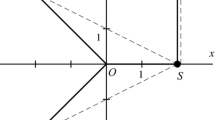Abstract
We introduce a new bargaining set for cooperative games in characteristic function form, and investigate its structure and properties. We prove that the new bargaining set is not empty. In fact, we show that it contains the kernel and is contained in the classical bargaining set \({\mathcal{M}^i_1}\), and we further prove that it consists of the unique symmetric vector for the class of simple majority games.
Similar content being viewed by others
References
Aumann RJ, Maschler M (1964) “The bargaining set for cooperative games”, advances in game theory. In: Dresher M, Shapley LS, Tucker A (eds) Annals of mathematics studies, No. 52. Princeton University Press, Princeton, pp 443–476
Davis M, Maschler M (1965) The kernel of a cooperative game. Naval Res Logist Quart 12: 223–259
Davis M, Maschler M (1967) Existence of stable payoff configurations for cooperative games. In: Shubik M (eds) Essays in mathematical economics in honor of Oskar Morgenstern. Princeton University Press, Princeton, pp 39–52
Driessen T (1994) Private communication
Driessen T (1998) A note on the inclusion of the kernel in the core of the bilateral assignment game. Int J Game Theory 27: 301–303
Granot D (1994) On a new bargaining set for cooperative games. (working paper)
Granot D, Maschler M (1997) The reactive bargaining set: Structure, dynamics and extension to NTU games. Int J Game Theory 26: 75–96
Granot D, Granot F, Zhu WR (1997) The reactive bargaining set of some flow games and superadditive simple games. Int J Game Theory 26: 207–214
Maschler M, Peleg B (1966) A characterization, existence proof and dimension bounds for the kernel of a game. Pacific J Math 18: 289–328
Maschler M, Peleg B (1967) The structure of the kernel of a cooperative game. SIAM J Appl Math 15: 569–604
Meertens MA, Potters JAM, Reijnierse JH (2007) On bargaining sets in symmetric games. Int Game Theory Rev 9: 199–214
Schmeidler D (1969) The nucleolus of a characteristic function game. SIAM J Appl Math 17: 1163–1170
Shapley LS, Shubik M (1972) The assignment game I: The core. Int J Game Theory 1: 111–130
Solymosi T (1999) On the bargaining set, kernel and core of superadditive games. Int J Game Theory 28: 229–240
Sudhölter P, Potters JAM (2001) The semireactive bargaining set of a cooperative game. Int J Game Theory 30: 117–139
von Neumann J, Morgenstern O (1953) Theory of games and economics behavior. Princeton University Press, Princeton, New Jersey (1st edn: 1944)
Author information
Authors and Affiliations
Corresponding author
Additional information
Michael Maschler was intrigued by the reactive bargaining concept, which was introduced in my unpublished paper (Granot (1994)). Accordingly, in one of his many visits to UBC, he wanted to compare and contrast the outcomes and insights it provides with those provided by the kernel and the classical bargaining set for some well known examples considered in the literature, including the Five Person Market Game example he analyzed in his paper in JET, 1976, where he has demonstrated an advantage of the (classical) bargaining set over the core, and the Seven Person Projective Game, first introduced by von Neumann and Morgenstern. So, we set about to study these examples, and, as usual, the focus was expanded, resulting with our joint paper in IJGT in 1997. In view of the interest my unpublished paper has generated, and its relevance to Michael’s work on the classical bargaining set and the kernel, I am delighted that a shorter version of it is appearing in an issue dedicated to Michael.
Research was partially supported by Natural Sciences and Engineering Research Council grant A4181.
Rights and permissions
About this article
Cite this article
Granot, D. The reactive bargaining set for cooperative games. Int J Game Theory 39, 163–170 (2010). https://doi.org/10.1007/s00182-009-0201-6
Accepted:
Published:
Issue Date:
DOI: https://doi.org/10.1007/s00182-009-0201-6




